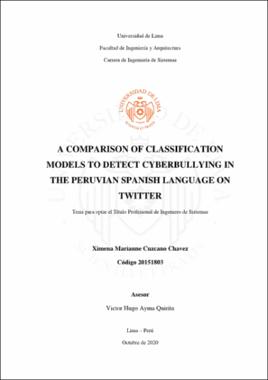A comparison of classification models to detect cyberbullying in the peruvian spanish language on Twitter

Ver/
Cuzcano_Chavez_Ximena_Marianne.pdf
(application/pdf: 312.0Kb)
(application/pdf: 312.0Kb)
Fecha
2020Autor(es)
Asesor(es)
Metadatos
Mostrar el registro completo del ítemResumen
Cyberbullying is a social problem in which bullies’
actions are more harmful than in traditional forms of bullying as they have the power to repeatedly humiliate the victim in front of an entire community through social media. Nowadays, multiple
works aim at detecting acts of cyberbullying via the analysis of
texts in social media publications written in one or more
languages; however, few investigations target the cyberbullying
detection in the Spanish language. In this work, we aim to
compare four traditional supervised machine learning methods
performances in detecting cyberbullying via the identification of
four cyberbullying-related categories on Twitter posts written in
the Peruvian Spanish language. Specifically, we trained and
tested the Naive Bayes, Multinomial Logistic Regression, Support
Vector Machines, and Random Forest classifiers upon a
manually annotated dataset with the help of human participants.
The results indicate that the best performing classifier for the cyberbullying detection task was the Support Vector Machine classifier.
Cómo citar
Cuzcano Chavez, X. M. (2020). A comparison of classification models to detect cyberbullying in the peruvian spanish language on Twitter [Tesis para optar el Título Profesional de Ingeniero de Sistemas, Universidad de Lima]. Repositorio institucional de la Universidad de Lima. https://hdl.handle.net/20.500.12724/12718Editor
Universidad de LimaColeccion(es)
- Tesis [68]
El ítem tiene asociados los siguientes ficheros de licencia:

